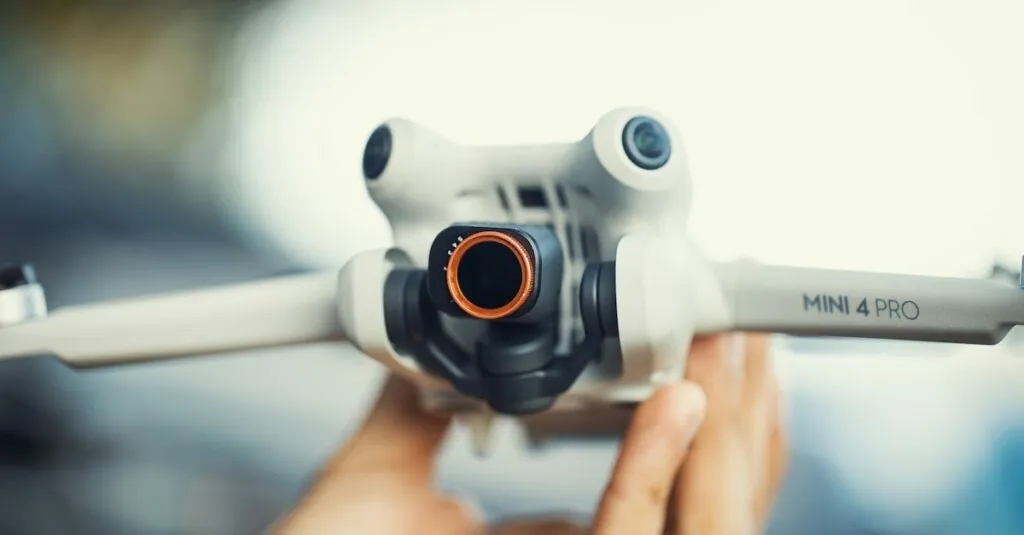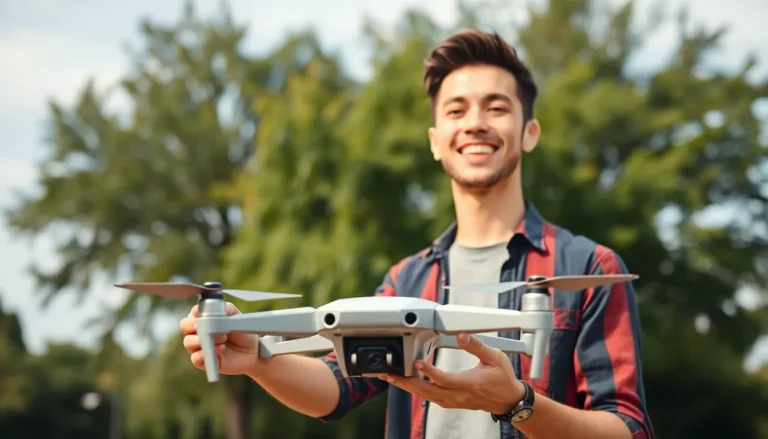Table of Contents
ToggleIn a world where technology often blurs the lines between convenience and chaos, the concept of “murder drones” takes center stage. These high-tech marvels aren’t just for delivering your latest online shopping spree; they could potentially be the next big thing in warfare. Imagine tiny flying robots equipped with a lethal arsenal—it’s like a sci-fi movie come to life, but with a lot less glamour and a lot more existential dread.
Overview of Murder Drones
Murder drones represent a significant shift in military technology. These unmanned aerial vehicles come equipped with advanced targeting systems and weapons, enabling them to engage in combat effectively. Designed for reconnaissance and precision strikes, they enhance the capabilities of military operations.
Advanced sensors allow these drones to operate in various environments, including urban settings. Concerns surrounding their use involve ethical considerations, given their potential to cause civilian casualties during conflicts. Many experts worry about accountability, particularly if these drones operate autonomously without human oversight.
Countries are developing and deploying murder drones at an alarming rate. The United States, Russia, and China lead the way in integrating these machines into their military strategies. Recent reports indicate that nations are investing heavily in drone technology for battlefield advantage.
Public opinion on murder drones varies widely. Some people view them as essential for modern warfare, providing a means to reduce troop casualties. Others express fears about the potential for abuse, arguing that reliance on drones detaches the human element from combat.
Future implications of murder drones remain uncertain. Predictions suggest that as technology progresses, these drones could become even more autonomous and sophisticated. The ongoing debate about their use will likely intensify as warfare evolves, highlighting the need for regulations to govern their deployment properly.
Features and Capabilities
Murder drones exhibit cutting-edge design and advanced technology, setting them apart from traditional UAVs. These flying machines often feature stealth characteristics, allowing them to evade detection. Built with lightweight materials, their agility enhances maneuverability, enabling precise navigation in various environments. Equipped with artificial intelligence, they can process data rapidly, improving their decision-making capabilities during operations.
Design and Technology
Design characteristics play a crucial role in the performance of murder drones. Many models boast compact sizes, which aid in covert missions. Several units incorporate high-definition cameras for real-time surveillance, providing valuable intelligence. Integrating GPS technology allows for accurate positioning and easy deployment in diverse conflict zones. Thermal imaging capabilities also enable effective operation in low-light conditions, enhancing overall effectiveness.
Weaponry and Targeting Systems
Weaponry on murder drones varies, with some armed with precision-guided munitions. Many drones utilize laser-guided systems, ensuring accurate strikes on designated targets. High-explosive payloads increase lethality while minimizing collateral damage. Advanced targeting systems rely on real-time data analysis, allowing for quick identification and engagement of threat sources. Such technology enhances operational efficiency, making these drones formidable assets in modern warfare.
Applications in Warfare
Murder drones play a transformative role in modern military operations, showcasing advanced technologies and strategic applications.
Case Studies
Recent conflicts illustrate the practical use of murder drones. In the 2020 Nagorno-Karabakh war, Azerbaijan effectively deployed drones for reconnaissance and precision strikes, achieving significant tactical advantages. Ukrainian forces utilized these drones to target Russian military assets, demonstrating their effectiveness in real-time combat scenarios. Various nations now experiment with drone technology to enhance operational efficiency. The U.S. military integrates drones into surveillance tasks, collecting intelligence while minimizing risk to personnel. Each case underscores the drones’ capabilities, revealing both their strategic value and growing prevalence in warfare.
Ethical Implications
Ethical considerations surrounding murder drones remain complex. Concerns exist about the potential for increased civilian casualties during operations. Autonomy raises questions regarding accountability when drones act without direct human oversight. Critics emphasize the necessity of regulations governing their use to ensure compliance with international laws. Additionally, the psychological impact on both operators and targets shapes the discourse around ethical deployment. Recognizing these implications is vital for policymakers as they navigate the challenges of advanced military technologies in conflict zones. Addressing these ethical dilemmas will influence future developments in drone warfare.
The Future of Murder Drones
Murder drones are set to change the landscape of modern warfare dramatically. Their technological evolution may lead to increased automation and enhanced capabilities.
Potential Developments
Advancements in artificial intelligence could drive the next generation of murder drones. Future iterations might feature improved autonomy, allowing them to make split-second decisions. Development teams also aim to enhance targeting systems, leading to higher precision in engagements. Innovations in stealth technology may reduce detection risks, enabling operations in hostile environments. Manufacturers are likely to create drones with longer flight times, expanding operational ranges. Continuous updates in sensor technology promise to boost surveillance capabilities, facilitating better real-time data analysis.
Global Reactions and Regulations
Responses to murder drones vary widely among nations and advocacy groups. Several governments support these technologies for their strategic advantages, while others express stark opposition due to ethical concerns. International organizations emphasize the need for regulations governing their use in combat. Negotiations addressing the humanitarian implications of autonomous warfare are ongoing. Countries like the United States and Russia face increased scrutiny regarding accountability and civilian safety. Discussions also focus on establishing frameworks to ensure compliance with existing humanitarian laws. Constructive dialogues may lead to clearer guidelines on how these drones can be ethically and safely integrated into military operations.
The rise of murder drones marks a pivotal moment in military technology. Their potential to reshape warfare is undeniable yet fraught with ethical dilemmas. As nations invest heavily in these advanced systems, the balance between strategic advantage and moral responsibility becomes increasingly complex.
The implications of deploying such technology extend beyond the battlefield. The potential for civilian casualties and the challenges of accountability in autonomous operations demand urgent attention from policymakers and international bodies. Establishing clear regulations is essential for ensuring the humane use of these powerful tools.
As the conversation around murder drones evolves, it’s crucial to prioritize discussions on ethics and accountability. The future of warfare may hinge on how society navigates these challenges and integrates technological advancements responsibly.







